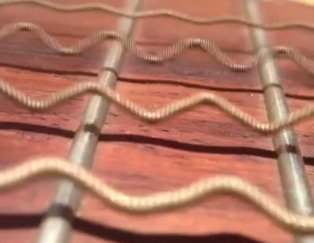At the end of last year, Viner Logan Gendizzle created this short loop of his guitar strings up close while he plays Weezer's "Say it Ain't So". The result is pretty spectacular-looking, and it's recently been doing the rounds online again for obvious reasons.
But, unfortunately, however interesting it is to look at, the video isn't actually showing the real vibration of the strings, as Joe Wolfe, physics and acoustics expert from UNSW Science in Sydney, Australia, explained to ScienceAlert when we contacted him about it.
Instead, what you're seeing is "almost certainly an artefact of a moderately slow camera," says Wolfe. Say it ain't so…
"From the two frets in view, we can see that the whole field of view of the camera is only a few centimetres in the foreground. From this and the movie, we would naively deduce that the largest amplitude waves on the strings had wavelengths of only a centimetre or so. In reality, the waves with these wavelengths will have very small amplitudes, and the large amplitude vibrations will have wavelengths of tens of centimetres," he explains.
So why does it look like this in the movie? Wolfe explains:
"The camera does not record all points in a picture at the same time – it scans across in lines from side to side (or sometimes top to bottom) until it has recorded a whole picture.
A more familiar example: Have you ever taken a movie from a high speed train or car window? Nearby objects like electricity posts seem to be leaning. Of course they are not, it's just that the camera has recorded the top of the post first and, when it gets to the bottom of the post, the train has moved on. It's more complicated when the object (like these strings) are vibrating."
But that doesn't mean that close-up guitar strings aren't equally fascinating. The reality is that they don't move nearly as much as the strings in that video, but there is still a very clear sine wave that travels along them, as you can see in the slow-motion footage below.
So how does this movement create the music that we love to hear?
"Ultimately, these vibrations create a travelling sound wave, and the pitch of the sound you hear depends on the frequency of the string's vibrations," says Wolfe.
A string can only vibrate so often, depending on the length of the standing wave that its vibration cause. So, generally, heavier strings will vibrate more slowly and have a longer wavelength, creating lower pitch, and finer strings will vibrate more frequently with shorter wavelengths, creating higher notes.
The length of the string that's available to move also determines the pitch of the note it creates, which is why placing your fingers down in different chord patterns will vary the sound you hear. Pitch is also affected by the tension in the string - which is controlled when you tune your instrument - and to a lesser extent, the way in which you pluck, as Wolfe explains.
Some of the energy of these vibrations is transmitted to the air by the body of an acoustic guitar, and spread out until they eventually hit your eardrum, transmitting the notes of your favourite song.
Find out more about how instruments produce sound, and how standing waves travel across strings, at Wolfe's pages here and here. You can also read about how his team solved a long-standing musical mystery on the twisting motion produced by a bow.
And enjoy some more amazing footage of strings really moving in all their sinous glory. As Wolfe explains, "the reality is more interesting but less amazing".
